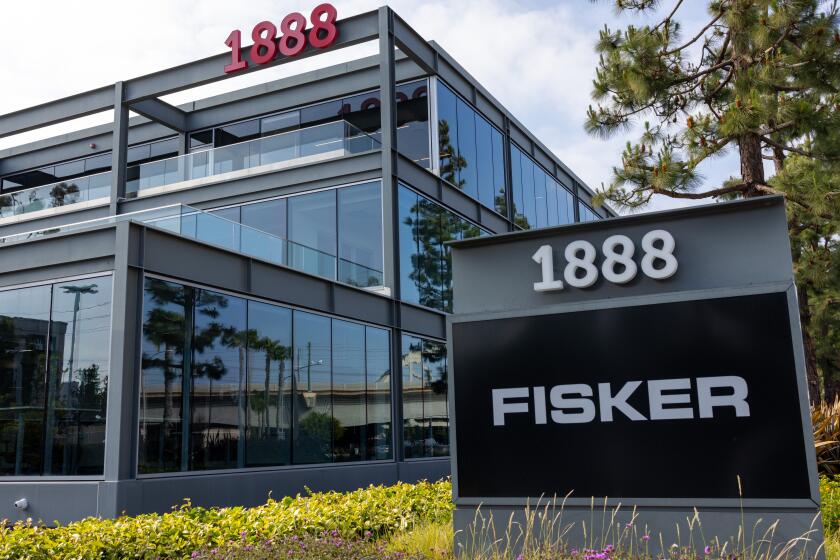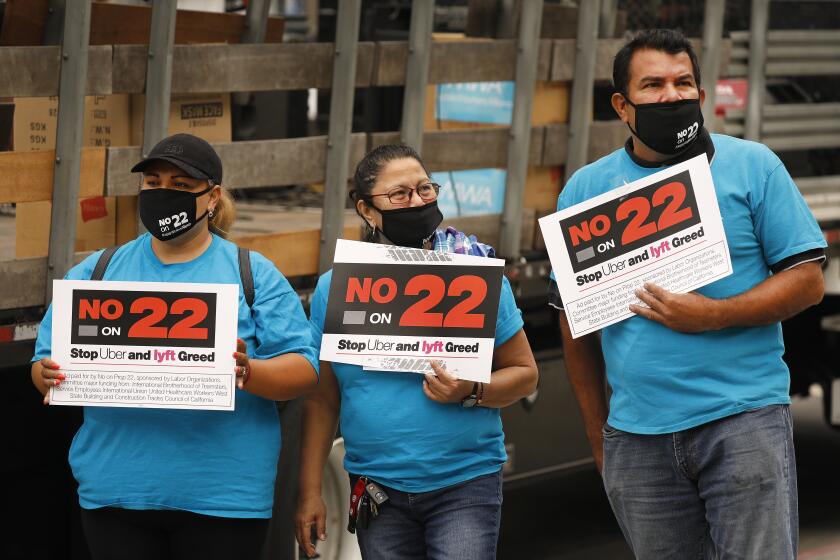Deals on wheels best at year’s end
Tough times for automakers make this a great time for car buyers.
Manufacturers and dealers have had to slash prices more than they have in decades -- and the bargains should soon be even sweeter as sellers push to move inventory before the end of the year.
“All the planets are aligned in your favor,” said W. James Bragg, who runs the car buying information service FightingChance.com. It’s the best time to buy a new car, Bragg said, in 15 years.
The days after Christmas -- before the new year begins -- are always a prime time to purchase a car. Business is slow and dealers often need to sell additional cars to meet monthly, quarterly and annual sales goals. At the end of this dismal year, dealers should be even more eager to end the year on a high note by selling you a car, which could also make them more willing to offer you a price unthinkable only a few months ago.
And even though automakers are desperate to sell, to get the best deal a buyer still needs to understand how cars are priced and sold -- a process as straight and as penetrable as the Great Wall of China. Fortunately, there’s now more information available to figure out what to pay and how to draw the best offer from a dealer, through both commercial websites and Internet forums organized by car enthusiasts. Here are some tips for bargain hunting after Christmas.
You can pay less than invoice -- sometimes way less: Just about everyone knows the sticker price is more than you should pay. Then there’s the “invoice” price, which is supposed to indicate what a dealer paid for the vehicle.
Many consumers are under the impression that the invoice price is a true wholesale cost and that dealers generally can’t sell a car for less without losing money.
That leads prospective buyers to look up invoice prices on websites such as Edmunds.com or KBB.com, and then negotiate upward from the stated invoice prices. Some car buying websites also deduct rebates and “holdback,” a system some manufacturers use to refund dealers 1% to 3% of a car’s value. Some also use sales data to come up with “true” prices for a region.
But a savvy buyer can sometimes get a price below the invoice price and the additional manufacturer’s rebates and discounts.
Knowing the invoice price is useful, but changes in the auto industry in the last few years have made invoice figures less significant, Bragg and other analysts say.
Car manufacturers now pay bonuses to dealers that meet specific sales targets. A large dealer may get hundreds of thousands of dollars for selling a set number of cars by the end of a quarter.
To hit one of those targets, a dealer may sell a car for a price well below invoice. They may tell you they’re giving you such a good deal they’re losing money, but of course they’ll make up for their “loss” when they get their hefty check from the manufacturer.
So how do you discover the lowest price?
Know the supply -- and demand: The Internet gives consumers access to information once available only to insiders. Car buying websites are good as a starting point, generally offering invoice prices, lists of rebates and current market value estimates for specific models. Beyond those sites, you should also check the individual manufacturers’ websites for current rebate offers.
Car buying and manufacturer websites are usually on top of current rebate offers, but they do miss some of them, and some are never publicized by manufacturers. Another source that can pay off, although somewhat inconsistent, is Internet user forums.
These are discussion groups often organized by individuals interested in the same model vehicle. Commercial sites like Edmunds.com also run model-specific forums.
You can enter the name of the car model you’re researching into a search engine (i.e. “Ford Mustang forum”) to find these discussion groups. There is typically a “prices paid” section on the message board, onto which people who have recently bought cars post the prices they paid, what rebates they received, etc.
It is also common for people who work at dealerships to post comments to these boards. They often will alert buyers to rebates that are not always publicized.
This fall, for instance, a dealer posted a notice on a forum about a rebate General Motors was offering for buyers in certain states who switched from another brand, called a “conquest” rebate. I had not seen the deal reported on the company website, and when I asked a saleswoman about rebates for the model, she said there were none.
“Isn’t there a conquest rebate?” I asked. “Oh, yes, we do have that,” she replied.
Along with pricing information, consumers can now check the supply of vehicles online for many models. On many manufacturer websites, you can enter your ZIP Code and the model you are seeking, and view the actual inventory on dealers’ lots.
You can usually view the car’s “window sticker” online to know exactly which options, colors, etc. are at a specific dealer. This information can also give you a sense of a dealer’s willingness to discount a car.
If you see on a dealer’s lot five models of a car you are interested in that match what you want, and several dealers nearby have similar stock, you’re probably in a strong bargaining position. Conversely, if there is only one model you want available in Southern California, you probably have less leverage.
There are other conclusions you can draw from the inventory websites. For instance, if you don’t mind a car from a previous model year, and you see a dealer still has half a dozen 2008 models on the lot, while 2009 models are piling up and 2010 models will be arriving soon, you should be able to get a great price on the 2008 car.
Don’t step into the lion’s den -- let dealers compete for your business: If you need to test drive a car, you should do so well in advance of your anticipated purchase date so that you’re less likely to make an impulse buy. Visit a dealer, take a drive, then thank the salesperson for his or her time and say you’ll be in touch when you are ready to buy.
When you are about to pull the trigger, stay out of the showrooms. Walk into a dealership to start a negotiation only if you’re the kind of person who thinks it’s fun to get locked into an hours-long haggling match in which you’re outnumbered; and if you’re OK with paying more than you likely could have by staying home.
Bragg and other experts recommend faxing or e-mailing a proposal to several dealers who have the car you want in stock. Bragg even includes a form letter to use in the kit he sells through his website.
In the letter, identify the type of car you’re interested in and the options you want. If you’ve done your Internet research, you can even specify a vehicle identification number, or VIN, to show that you’re aware a car is on their lot, and clearly state that you are ready to buy the car within a few days. Do this only if you are truly ready -- you need to be honest in your letter.
Do not reveal what you are willing to pay. Instead, list the invoice price for the car and rebates you should be aware of through your Internet searching and state what you believe to be that amount. Then ask the dealership for its best price. Some dealers will not answer you. But within a couple of hours, you should have at least a couple of replies. In my experience, the prices offered have sometimes been lower than what I had in mind, sometimes a lot lower.
If you have two or more offers that are close, ask the dealers whose prices closely match the lowest offer if they can beat it. Again, emphasize that you are not playing with them and you will buy the car if the price is right. If someone matches the lowest offer, contact the dealership whose price was lowest, say you have matching offers from other dealers and ask if they can beat the price.
At this point the offers probably will be very close, and you may want to pick the dealer you feel comfortable with, or the one closest to your home. Further negotiating may not be worthwhile.
“Do you really want to spend two or three days going back and forth between car dealers to save another $100 or $200?” Bragg said.
Do your final negotiating on a day you’re ready to pick up the car, so you can go directly to the car lot once you’ve agreed on a price. I once negotiated a price this way but delayed my trip to the dealer, who sold the car to another buyer before I came in. Luckily he had another model for me at the same price.
Pick up your car -- but don’t be a jerk: After you’ve agreed to the deal, go to the dealership and pick up the car. Because you’ve already agreed on a price, don’t try any stunts like badgering the dealer for more of a discount or threatening to back out of the deal unless they offer you some extras.
One common complaint from salespeople on Internet message boards is that buyers treat them rudely or accuse them of gouging, even when they’re offering their rock-bottom price. When you’ve already been promised a low price, it’s doubtful that pestering a salesperson will get you anything more than ill will.
Dealers are also rewarded -- sometimes with large amounts of money from manufacturers -- for high marks on customer satisfaction surveys. If you let them know that you’re having a positive car-buying experience and that you’ll give them the highest scores when you are surveyed by the manufacturer, a dealer will certainly appreciate it, and may thank you with a few extra bucks off the deal.
There’s no harm in asking very politely whether the dealer can cut from the price -- you may get another couple of hundred dollars off or some coupons for free oil changes or car washes -- but don’t expect more when you’ve agreed to a firm price. I recently got some nifty floor mats. Be grateful if this happens -- they’re doing you a favor.
I like to send a thank you letter if a dealer has treated me well, naming each person who worked on the deal.
On the other hand, if a dealer tries to add charges to the price on which you agreed or aggressively pushes add-ons you don’t want such as extended warranties, by all means walk out the door. You should have offers from other dealers in hand, so you’ll know where to turn.
Drive a hard bargain, and you should be happily driving home in a new car before the new year.
--
More to Read
Inside the business of entertainment
The Wide Shot brings you news, analysis and insights on everything from streaming wars to production — and what it all means for the future.
You may occasionally receive promotional content from the Los Angeles Times.










